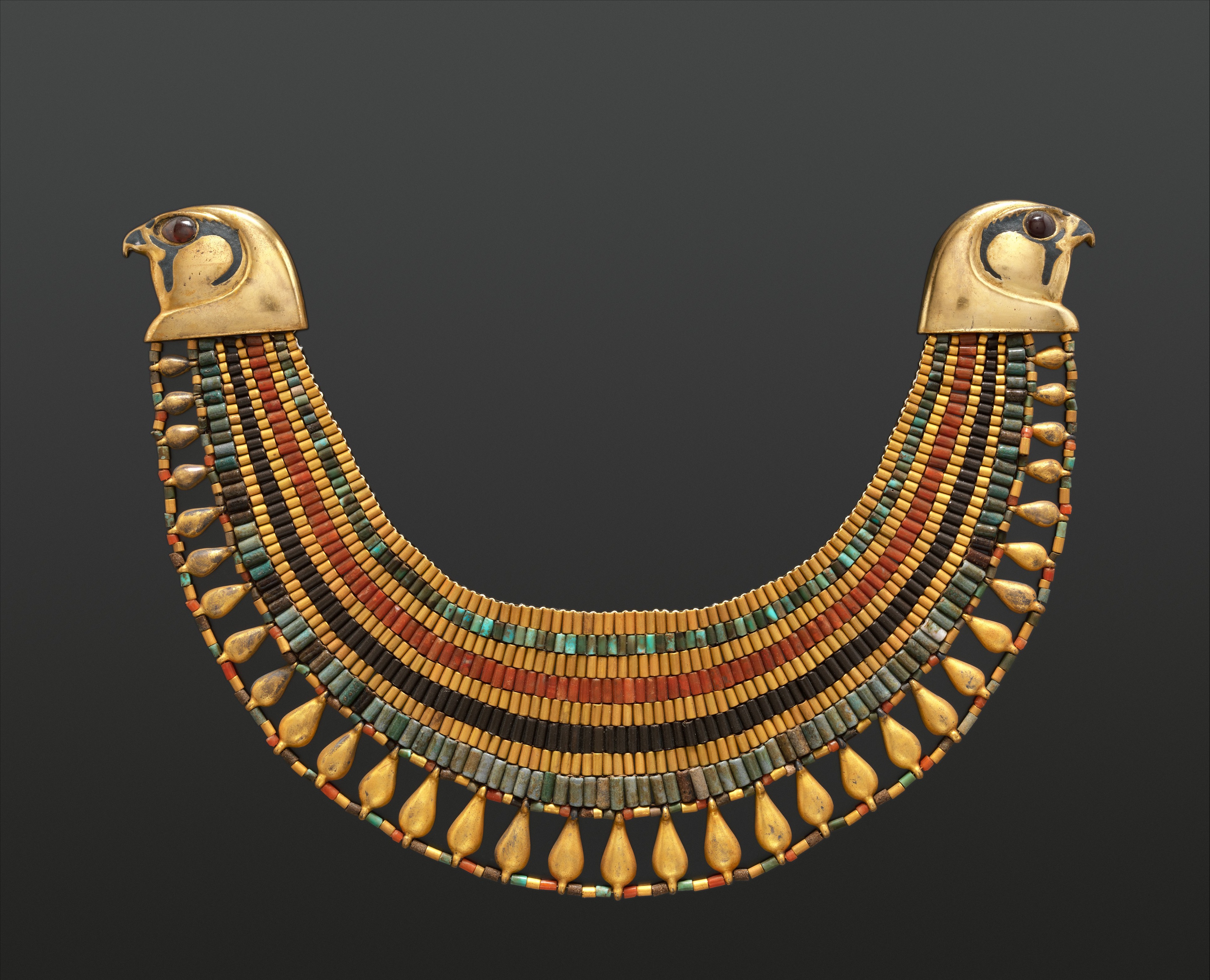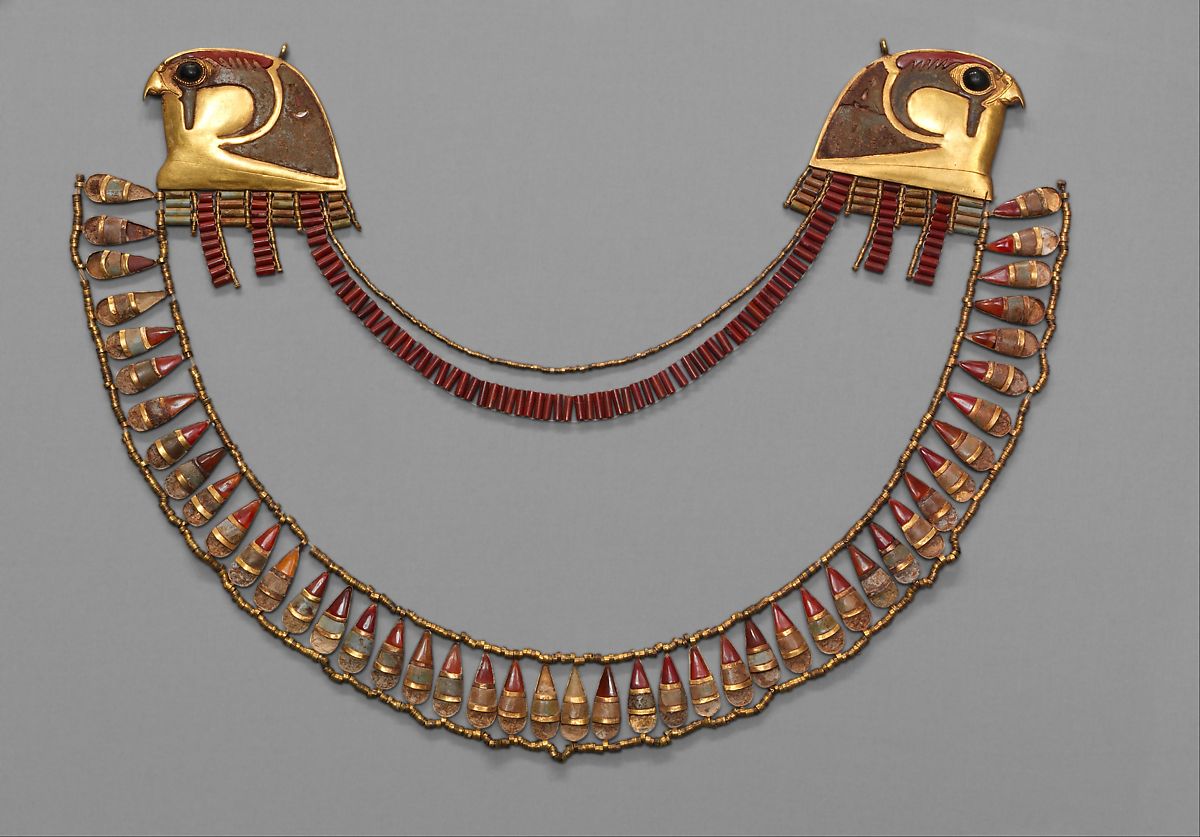Usekh collar on:
[Wikipedia]
[Google]
[Amazon]

 As early as the Old Kingdom (circa 2670–2195 B.C.), Egyptian artisans fashioned images of gods, kings, and mortals wearing broad collars made of molded tubular and teardrop beads. The Usekh or Wesekh is a personal ornament, a type of broad
As early as the Old Kingdom (circa 2670–2195 B.C.), Egyptian artisans fashioned images of gods, kings, and mortals wearing broad collars made of molded tubular and teardrop beads. The Usekh or Wesekh is a personal ornament, a type of broad 


 As early as the Old Kingdom (circa 2670–2195 B.C.), Egyptian artisans fashioned images of gods, kings, and mortals wearing broad collars made of molded tubular and teardrop beads. The Usekh or Wesekh is a personal ornament, a type of broad
As early as the Old Kingdom (circa 2670–2195 B.C.), Egyptian artisans fashioned images of gods, kings, and mortals wearing broad collars made of molded tubular and teardrop beads. The Usekh or Wesekh is a personal ornament, a type of broad collar
Collar may refer to:
Human neckwear
*Clerical collar (informally ''dog collar''), a distinctive collar used by the clergy of some Christian religious denominations
*Collar (clothing), the part of a garment that fastens around or frames the neck
...
or necklace
A necklace is an article of jewellery that is worn around the neck. Necklaces may have been one of the earliest types of adornment worn by humans. They often serve Ceremony, ceremonial, Religion, religious, magic (illusion), magical, or Funerary ...
, familiar to many because of its presence in images of the ancient Egyptian elite. Deities
A deity or god is a supernatural being who is considered divine or sacred. The ''Oxford Dictionary of English'' defines deity as a god or goddess, or anything revered as divine. C. Scott Littleton defines a deity as "a being with powers greate ...
, women, and men were depicted wearing this jewelry. One example can be seen on the famous gold mask of Tutankhamun
The mask of Tutankhamun is a gold mask of the 18th-dynasty ancient Egyptian pharaoh Tutankhamun (reigned 1334–1325 BC). It was discovered by Howard Carter in 1925 in tomb KV62 in the Valley of the Kings, and is now housed in the Egyptian Mu ...
. The ancient word ''wsẖ'' can mean "breadth" or "width" in the Ancient Egyptian language
The Egyptian language or Ancient Egyptian ( ) is a dead Afro-Asiatic language that was spoken in ancient Egypt. It is known today from a large corpus of surviving texts which were made accessible to the modern world following the decipherm ...
and so this adornment is often referred to as the broad collar.
The usekh broad collar was wrapped around and supported by the neck and shoulders. It is typically adorned with closely placed rows of colored stone beads, or it is made entirely of metal. The collars were connected with clasps of gold.
Over time across Ancient Egyptian history we witness profound changes to the broad collar. This could be attributed to a shifting mythological perspectives or perhaps due to geographical movement across Egypt.
A scene in the 4th Dynasty
The Fourth Dynasty of ancient Egypt (notated Dynasty IV) is characterized as a "golden age" of the Old Kingdom of Egypt. Dynasty IV lasted from to 2494 BC. It was a time of peace and prosperity as well as one during which trade with other ...
tomb of Wepemnofret
Wepemnofret was a Royal prince of the Fourth Dynasty.
His father was Khufu, and mother unknown. A stela embedded in the wall of his tomb was found near the Great Pyramid of Giza
The Great Pyramid of Giza is the biggest Egyptian pyramid and t ...
at Giza
Giza (; sometimes spelled ''Gizah'' arz, الجيزة ' ) is the second-largest city in Egypt after Cairo and fourth-largest city in Africa after Kinshasa, Lagos and Cairo. It is the capital of Giza Governorate with a total population of 9.2 ...
connects the usekh collar with dwarfs and the deity Ptah
Ptah ( egy, ptḥ, reconstructed ; grc, Φθά; cop, ⲡⲧⲁϩ; Phoenician: 𐤐𐤕𐤇, romanized: ptḥ) is an ancient Egyptian deity, a creator god and patron deity of craftsmen and architects. In the triad of Memphis, he is the h ...
. Bernd Scheel has argued that Ptah, who is sometimes depicted wearing the broad collar, protects the deceased through the collar and that dwarfs had access to that protective magic because of their work making these types of collars. In the 5th Dynasty tomb chapel of Akhethotep (originally located at the Saqqara
Saqqara ( ar, سقارة, ), also spelled Sakkara or Saccara in English , is an Egyptian village in Giza Governorate, that contains ancient burial grounds of Egyptian royalty, serving as the necropolis for the ancient Egyptian capital, Memphis. ...
burial ground, now in the Louvre), one scene distinguishes between two types of collars: the broad collar and the ''šnw'' or "encircling" collar.


See also
*Clothing in ancient Egypt
Ancient Egyptian clothes refers to clothing worn in ancient Egypt from the end of the Neolithic period (prior to 3100 BC) to the collapse of the Ptolemaic Kingdom with the death of Cleopatra in 30 BC. Egyptian clothing was filled with a vari ...
References
External links
Necklaces Egyptian artefact types {{AncientEgypt-stub